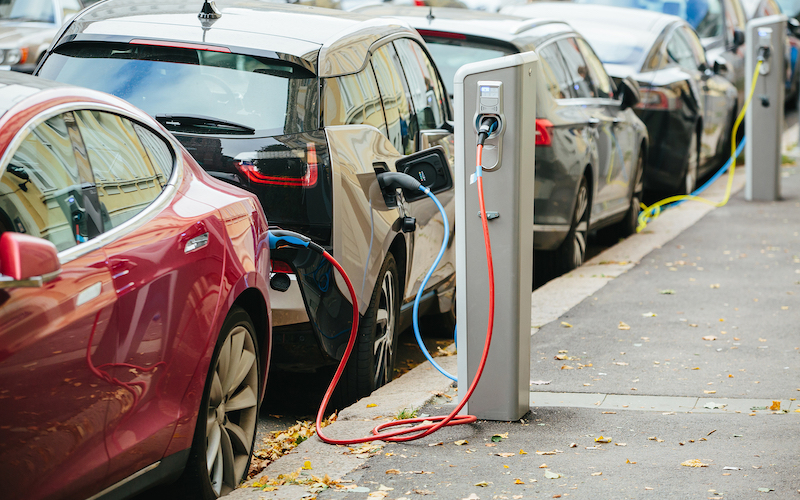
We need more affordable and accessible electric vehicles across New England to slow climate change. That means we have to ensure the way we mine for their components doesn't hurt people or the environment. Photo: Shutterstock.
I first learned about climate change through a song when I was in middle school. The music video, filmed north of the Arctic Circle, showed how climate change was impacting people’s livelihoods in Greenland. It also talked about how sea ice was already at lower levels since filming the video.
I was born in Albania, a small Eastern European country. The idea this music video presented – that our actions have impacts beyond our borders – stuck with me well into my adulthood. Climate change is a global problem, influencing every country. I began to question how I, as an individual now living in the U.S., could help slow the crisis around the world.
The Answer Lies in Breaking Free from Fossil Fuels
We must slash climate-damaging pollution that comes from burning fossil fuels like gas, oil, and coal. My work as an environmental lawyer continues to show me just how many aspects of our day-to-day lives rely on fossil fuels.
Our transportation system is one such area that depends on these dirty fuels and is responsible for the most climate-warming emissions in the nation. Electrifying our public transportation system, like trains and buses, and having more electric vehicles on the road are critical strategies for slowing climate change and protecting our future.
Demand for electric vehicles is rapidly increasing, in part due to new incentives created by laws such as the Inflation Reduction Act. Other legal mandates and incentives are also making electric cars and trucks more accessible and widespread.
But the surge in electric vehicle demand raises an important question: How can New England and the U.S. become a model for responsible mining of the minerals needed to power them?
How Do Electric Vehicles Slow Climate Change?
Transportation accounts for 40% of climate-damaging emissions throughout New England and 33% in the U.S. as a whole. That makes it the largest climate polluting sector in the nation. These emissions are caused by gas- or diesel-powered cars, trucks, trains, and airplanes.
Transitioning off fossil fuels will slow down climate change and reduce the increasing severity of flooding, extreme heat, and unpredictable weather. In Massachusetts, for example, electrifying the transportation system can lower annual emissions caused by fossil fuels by up to 35% by 2030.
Is There Any Concern about Having More Electric Vehicles on the Road?
Minerals in electric vehicle batteries, such as lithium, cobalt, nickel, manganese, and graphite, are essential to many modern technologies like laptops, cell phones, and televisions.
But currently, these materials are mined outside the U.S. For example, the Democratic Republic of the Congo produces 70% of the world’s cobalt, while 75% of the world’s lithium comes from South America, including Chile, Bolivia, and Argentina.
I first heard about these minerals ten years ago. A mentor from the Democratic Republic of Congo told me about the mining industry and the toll it took on families in her country.
And that’s the reality right now: Mining for these minerals across the world can harm the environment and communities living near the mines, particularly Indigenous Peoples, low-income communities, and people of color. Some mines worsen stormwater runoff and water pollution, degrade air quality, and hurt ecosystems and wildlife. Mining also contributes to human rights abuses, including the abhorrent practice of child labor in dangerous conditions.
Now these impacts are not limited to electric vehicles – the extraction of fossil fuel and oil-based products is equally, if not more, intensive and harmful to the environment and people. But given the spike in demand of electric vehicles, every country prioritizing this climate solution has a duty to acknowledge their environmental impact and create new legislation, regulations, and programs to reduce the harm of these practices.
Is the U.S. Doing Anything about Sourcing These Minerals Domestically?
The Inflation Reduction Act mandates that automakers must now include a certain percentage of domestically mined minerals in electric vehicle batteries to qualify for federal tax credits. The Infrastructure Investment and Jobs Act promotes domestic manufacturing by building and expanding commercial facilities to process minerals for electric vehicle batteries. It also encourages battery recycling by funding research about how the materials can be reused and includes grants for battery collection, recycling, and reprocessing projects.
These laws incentivize sourcing, manufacturing, and assembling electric vehicle batteries within the U.S., which will create more local jobs. They also can potentially relieve the burden on other countries by ensuring that harmful mining is not imposed onto them.
Domestic mining can be better regulated since mining operators would have to comply with local, state, and federal environmental standards, resulting in a safer experience for people and the environment. And these mineral deposits exist across the U.S. For example, Maine contains a mine estimated to have a higher percentage of lithium than any other deposit worldwide.
Can We Protect People and the Environment during the Mining Process?
Importantly, we cannot replicate dangerous mining practices by further burdening those already experiencing climate change’s impacts, including low-income communities and people of color. New domestic mines must follow environmental standards and practices that reduce air and water pollution from mining waste and do not increase any other environmental burdens for communities located nearby.
Additionally, advocates must continue to fight for stricter review of new mines so that the need for minerals does not worsen inequities, such as land-grabbing or displacing people from their homes – an injustice that has occurred far too often.
Several policy changes, including those from the Interagency Working Group on Mining Laws created in 2022, can further protect communities and the environment during the mining process, such as:
- Urging elected officials to update mining laws and include stricter environmental review processes for approving mine sites and permitting requirements for mineral developers;
- Incentivizing car companies to take accountability for their mining impact by joining programs that assess mines and mining processes and provide certifications that companies meet environmental, public health, and environmental justice standards;
- Increasing community engagement with those living nearby mining sites within the environmental review process; and
- Improving recycling standards at the state and federal level and standardizing a uniform design for batteries created in the U.S. to enable more recycling.
The Takeaway: Electric Vehicles Can Slow Climate Change and Protect the Environment.
Electric vehicles are crucial to fighting climate change. But as we continue to electrify our transportation systems, we must guarantee our actions do not create unintended harm to people – whether that’s across the world in countries like the Democratic Republic of Congo or right here at home in New England. Through careful and intentional policymaking and legislation, domestic electric vehicle mining can drive forward our clean energy transition without hurting people or the environment.



